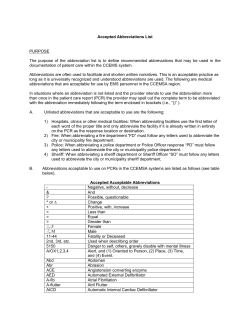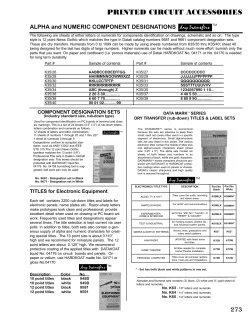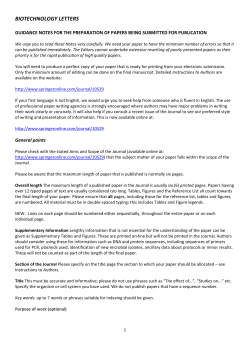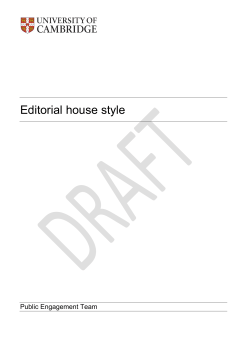
Joseph Rowntree Foundation House style guide Introduction
Joseph Rowntree Foundation House style guide Introduction This guide is for authors and editors who are working on publications and other forms of written communication for the Joseph Rowntree Foundation (JRF). The guide is designed to help you write clear and consistent content for the web or print, and to make it easy for you to find answers to any queries you might have about writing or editing for JRF. You can either read the whole guide from start to finish if you haven’t written/edited for JRF before, or use the contents page (page 2) to quickly find the specific information you’re looking for. Short, separate guidelines are available here – http://www.jrf.org.uk/funding/currentfunding-holders – for: writing a JRF report writing a JRF Findings writing a JRF Round-up writing a JRF Solutions writing a JRF Viewpoint writing a JRF programme paper submitting text and graphics This guide was last updated in November 2012. 1 Contents Writing for JRF publications Our writing style – the basics Titles Web readability Structure Tense 3 3 3 4 5 5 When and how to use… Abbreviations, acronyms, contractions and jargon Capital letters Figures, tables and boxes Hyphens Italics Lists, including bullet points Numbers, including date and time Plural or singular Quotations 6 6 7 8 8 8 9 9 9 9 How to refer to… Acts, bills, white papers, green papers and legal cases Britain, Great Britain and the United Kingdom Groups of people The Joseph Rowntree Foundation Other organisations and publications 10 10 10 11 12 12 More about… Spellings Spacing 12 12 12 Notes and references Notes, including footnotes and end notes References 12 12 13 2 Writing for JRF publications Our writing style – the basics “Be short, be simple, be human.” Ernest Gowers, The Complete Plain Words Here are some simple things to bear in mind when you write for JRF: Keep the reader in mind as you write and remember that our publications are primarily accessed via our website. If web users can’t quickly grasp what your work is about, you can easily lose them. Be concise and direct. Never use a long word where a short one will do, and keep sentences and paragraphs brief and to the point. If it is possible to cut a word out, cut it out. Write objectively and factually and avoid dramatic, emotive language. Be politically independent. Use the active instead of the passive voice to make your writing tighter, snappier and more immediate – for example ‘Fred rowed the boat across the lake’ (active) rather than ‘The boat was rowed across the lake by Fred’ (passive). Never use a foreign phrase or jargon if you can think of an everyday English equivalent, and avoid clichés. Be clear and accurate, and avoid vague, abstract or meaningless words and descriptions, which can obscure meaning and clutter up your copy. Titles Titles should be clear, short, understandable and descriptive, giving an immediate and clear indication of the subject matter. They should not be ‘quirky’. A quirky title might sound good but is useless in internet searches, where web users are searching for keywords. Titles are of critical importance on the web (see ‘Web readability’). A clear title containing search keywords will help ensure that your document is ranked well by search engines and will help your reader find it among the clutter of their results pages. Eye-tracking studies show that when scanning search engine results pages, the eye of the (Western) reader fixes on the top left area of text (see images on page 4). By ensuring that the first words of a title carry the key information, your work is more likely to be found and read. 3 This figure shows 'heat maps' from user eye-tracking studies of three websites. Copyright: F-shaped pattern for reading web content (Jakob Nielsen, 2006). The areas where users looked the most are coloured red; the yellow areas indicate fewer views; followed by the least-viewed blue areas. Grey areas didn’t attract any views. In particular, note the image on the right – a Google search results page that indicates just how important the first words of a document title are. See www.useit.com/alertbox/reading_pattern.html for more information. Web readability The most common way for people to access JRF documents is via JRF’s website (although many print off copies of what they find). Web users are often in a hurry, and reading from a screen is tiring, so it is a mistake to expect online readers to be as thorough as print readers. Make sure it’s easy for them to find, read and understand your key points and conclusions. Short, clear pages that are easy to scan draw people in and keep them reading. And a clear, short document works just as well – if not better – when printed. More information on writing for the web can be found at: www.useit.com/papers/webwriting/ 4 Structure Most publications produced for JRF follow a straightforward, standard structure, around which you should organise your writing. Each of these has separate guidelines – see page 1 or go to www.jrf.org.uk/funding/current-funding-holders The essential things to think about are: Who is going to read the document? What will they expect to get from it? When, where and how will they be reading it? What are you trying to achieve by writing it? Once you begin writing your document, remember that your goal is to organise material so that readers can get what they want in the shortest possible time. Some of this will be achieved by good structure. Other tools include: Bulleted lists. These extract significant points and draw the reader’s eye. They can be overdone – beware of lists within lists – but used well they are a definite help. Figures, tables and boxes: People absorb information graphically. If you can put some of your facts into a graph or a table, please do so. Boxes can be used to highlight nuggets of vital information. Subheadings: Let readers know where they are in the information flow. This is known as ‘signposting’. Meaningful, short sub-headings help break the text into digestible parts. They also help the reader to scan through the copy. The first few words of a heading are vital (see note on ‘Titles’). Don’t number subheadings or headings – only chapters should be numbered. Appendices: Use these to keep the main document clear of detail that might otherwise overwhelm the reader. Tense In most cases, the past historic tense is the right one to use, e.g. ‘Working mothers felt they were juggling home and work responsibilities’, not: ‘Working mothers feel they are juggling home and work responsibilities’. 5 When and how to use… Abbreviations, acronyms, contractions and jargon Abbreviations and acronyms Keep the use of acronyms, initials and abbreviations to a minimum. Some specific points: Use full stops in lower-case abbreviations such as i.e., e.g., and also in etc., Co., p. (page) and pp. (pages). No full stops should be used in upper-case abbreviations (such as UK, US etc.) and no full stops in measurement abbreviations such as mm, kg and so on. Capitalised acronyms do not need full stops either. Abbreviated units of measurement do not take a final ‘s’ in the plural, for example 50ml. Please be consistent with use of metric units and abbreviations. It can be useful to readers to include a glossary of all abbreviations and acronyms used in the text. Use acronyms for proper terms – DEFRA (Department for Education, Food and Rural Affairs) – but not for unofficial terms such as V&CS (voluntary and community sector). When you first use an acronym, put it in brackets after the full name, e.g. Joseph Rowntree Foundation (JRF) Contractions Contractions ending with the same letter as the original word do not take a final full stop: Mr, Dr, St, plc, 1st and so on. Contractions – don’t, won’t, can’t, etc. – are acceptable in directly reported speech but should be avoided in general. Avoid using ampersands (&) except in common acronyms/names, such as B&Q or Marks & Spencer. Jargon Yesterday’s jargon can become so entrenched in policy debate that it is impossible to avoid, but it is best to treat jargon and specialist terms with caution. If you think readers will not understand the word, it is better to use something else. If certain technical terms are central to your work, please ensure they are clearly explained the first time you use them. Try to avoid using new verbs that have been formed from nouns such as ‘operationalise’ (use ‘put into practice’, instead). 6 Capital letters We prefer minimal use of capitalisation. Names of people and places (proper nouns) always begin with a capital letter, and we also use upper case in the following instances, where we are talking about something specific rather than general: Benefits and government programmes – ‘Most would agree that benefits (general) play an important part in this. In particular, interviewees confirmed that both Income Support and Housing Benefit (specific)…’ ‘A number of government programmes (general) – including the New Deal for Lone Parents (specific) – fall into this category.’ Government/government – If you are referring to a specific government, such as the Coalition Government, use capital letters, e.g. ‘The Brown Government (specific) is bucking the trend established by previous governments (general).’ If you write about ‘government’ (rather than ‘the government’), make it clear whether you mean a specific government or governments in general. Job titles – ‘Among government ministers (general), Housing Minister (specific) Jane Smith is unique.’ Official bodies – ‘York Housing Association (specific) is one of the housing associations (general) that …’ ‘Not many borough councils (general) can compete with Lambeth Borough Council (specific) when it comes to …’ Regions – ‘Roads leading south (a direction, not a place) from the city centre are congested during the rush hour.’ ‘The population is concentrated in the north-east of the country (not a place name), not South East London (a specific region).’ Royalty – ‘The Queen of Spain (specific) shares with other kings and queens (general)…’ Specific religious institutions and buildings – ‘The Church of England (specific) owns many churches (general) in need of refurbishment.’ Titles and headings – Use an initial capital for the first word and all subsequent proper nouns (names of people and places) in all titles, subtitles, headings and subheadings, e.g. ‘What have we here? A brief biography of Byron’. Don’t use capital letters to EMPHASISE certain words or phrases. Also see the ‘How to refer to…’ section for more about using capital letters. 7 Figures, tables and boxes Always supply your figures separately, not embedded in Word files. See our ‘Supplying text and graphics’ guide. Boxes, figures and tables should always be cross-referenced in the text and should always be numbered consecutively, e.g. 1, 2, 3 etc. Text references to boxes, figures and tables should be in the style: ‘The comparison of trainees and other interviewees revealed a broadly similar pattern between the two groups (see Table 3).’ All boxes, figures and tables should have captions. These should appear at the top of the box, figure or table and be in the style: ‘Table 3: How to make a perfect soufflé’. As with titles, captions take an initial capital letter for the first word and any proper nouns. No full stop at the end of the caption. Notes on the content of boxes, figures or tables should be in plain text immediately below them. Please include the source of the information in boxes, figures and tables. Sources should appear after notes (if used) and should begin ‘Source:’. Hyphens Generally speaking, we prefer minimal use of hyphens. However, hyphens can be very useful for clarifying meaning: They join two or more words to form a single expression: ‘get-at-able’. Hyphenate two or more adjectives when they express a single idea, for example: ‘a well-dressed man’ is not the same as ‘a well, dressed man’. They join a prefix to a proper name: ‘pro-Darwin’. They separate a prefix from the main word to clarify meaning: recover/recover, re-sign/resign. They separate two similar consonant or vowel sounds: co-operate, Rossshire. They represent a common element in a list: ‘two-, three- or fourfold’. We follow the style below for the following: Email decision-makers hearing impaired people home-owners owner-occupiers policy-makers Italics may be used for titles and foreign words/phrases; may also be used for added or original emphasis in quotations and direct speech; should not be used to emphasise certain words or phrases in the main text. See the ‘How to refer to…’ section for other uses of italics. 8 Lists Use bullets rather than numbered lists unless there is cross-referencing, the bullets are in a sequence or they are in order of importance. There should be a line space before and after bulleted lists, and between each bullet. Try not to include more than five or six bullet points in a list. No unpunctuated bullet points. Where each point is a full sentence, introduce with a capital letter and close with a full stop. Otherwise, introduce each point with a lower-case letter, close each point with a semi-colon, and close the final point with a full stop. Numbers Statistics: round up figures under ten to the nearest whole unit unless there is a very clear need to be precise (e.g. 8 per cent rather than 7.7 per cent). Present ranges of numbers in the shortest form possible: 123–7, 1860–5. But retain ‘tens’ in 18–19, 1914–18. Spell out numbers in text up to and including twelve. But be consistent: use ‘eleven to thirteen’ rather than ‘eleven to 13’. Never start a sentence with a figure: spell out instead. Use figures for ages (12 years old), measurements (12 light years, 10 millimetres, 2 hectares), all percentages and abbreviations (such as kg, km). Round numbers above 999 may be spelled out: two thousand, two million, five thousand. Use per cent not % unless it occurs frequently or the piece is very statistical. Use % in tables, figures and boxes. Use commas in four- and five-figure numbers, e.g. 1,000, 10,000. Dates and time Use the form 5 August 2007. Refer to ‘the 1930s’ (not ‘the 1930’s’, ‘the ‘30s’, ‘the 30’s’ or ‘the Thirties’). Times should be in the form 10am rather than 10 am or 10a.m. Plural and singular Data is treated as a single noun, e.g. The data shows that... Companies and organisations are treated as singular, e.g. ‘JRF has published…’, rather than ‘JRF have published…’. If you’re writing about a person but can’t or don’t want to indicate their gender, use ‘their’ instead of ‘his’ or ‘her’, e.g. ‘Each child was asked whether their parents read with them at home.’ When possible, however, use a plural noun: ‘All the children were asked whether their parents read to them at home.’ Quotations Quotations should always be attributed, even if you need to do so broadly (e.g. mother, social worker) to preserve someone’s anonymity – see example on page 10. 9 Attributions should appear on a new line under the quote, left-aligned, no parenthesis/brackets. Extract quotations of more than 40 words, in the following style: “I am a barber … There are six of us who work in our shop, mainly Greek Cypriots and North Africans … My clients are from all communities you can imagine living in London, including regular Serbian clients … There, I have an obligation to accept and respect everyone…” Kosovar Albanian man, in his 50s. Dialogue within quotations retains its own inverted commas. Use single inverted commas (‘ ’) for non-extracted, quoted material. Speech, and quotations within quotations, take double inverted commas (“ ”). Use single inverted commas for introducing awkward or unusual terminology. Use square brackets ([ ]) to mark any author’s interjections or linking material. Use three points for ellipses, with a space on either side, to indicate omissions. If a sentence in a quotation is left hanging, close it as follows: “I wanted to do that, but …”. We prefer the standardisation of reported speech to any attempt to replicate individual speech patterns/dialect using either the standard alphabet or phonetic transcription. We want to ensure the meaning is clear to as many readers as possible. Swearing or derogatory language is acceptable in relevant direct quotes. How to refer to… Acts, bills, white papers, green papers and legal cases The title of Acts of Parliament should appear in plain text (not italic) with no comma between the title and the year, as follows: ‘the Finance Act 2006’. Use italic for the titles of bills (proposed new laws), white papers (parliamentary papers laying out government policy) and green papers (consultation documents). All main words should have an initial capital letter. Businesses and non-parliamentary bodies frequently issue white and green papers of their own and these should be treated in the same way. The names of parties in legal cases should be in italic, with the v. between in plain text and with a full stop. The year of the case appears in plain text and in brackets: e.g. ‘Marks v. Spencer (2007)’. Britain, Great Britain and the United Kingdom (UK) Be clear which of these you are referring to. Britain is a geographical term describing the island containing England, Wales and Scotland. Great Britain is the political unit that encompasses these countries. The United Kingdom is a political unit that includes these countries and Northern Ireland (but not the Isle of Man and the Channel Isles). The British Isles is a geographical term that includes the United Kingdom, Ireland and the surrounding islands. 10 Groups of people This is a sensitive area. Accepted language is constantly changing, and can vary between different groups and individuals, or depending on context. Please seek advice on acceptable current practice if you’re not sure. Once you have established which group you are speaking about, use ‘people’, ‘interviewees’ or participants’ etc. to avoid repetition. JRF prefers the following: Use people in/experiencing poverty, people on a low income, people receiving benefits (as appropriate) people with dementia Don’t use the poor, poor people, people dependent on benefits dementia sufferers homeless people disabled people men/women people non-disabled people people with learning disabilities (some groups prefer ‘people with learning difficulties’) the homeless the disabled males/females persons able-bodied people learning disabled people, except where phrase is used in titles of other works, government programmes etc. elderly people the old older people Sometimes people aged 85 and over are referred to as ‘very old’ or ‘much older’ people, but we prefer ‘people aged over 85’ care staff or care practitioners (paid staff) Gypsies/Travellers (capital letter) people from minority ethnic communities, minority ethnic groups, ethnic minority groups black* carer (unless applying to 'informal' or unpaid carers) ethnic minorities/ minority ethnics people with hearing impairments Blind people with visual impairments Black, BME, black afro, AfroCaribbean White Deaf (unless being used to define a cultural identity, as a linguistic minority); the deaf hard of hearing Blind; the blind partially blind people with mental health problems mentally ill white* deaf * Census or cultural terms may require a capital letter. 11 The Joseph Rowntree Foundation Abbreviate to ‘JRF’, not ‘the JRF’. Do not use Rowntree, the Foundation, or the Rowntree Foundation, and never the Rowntree Trust. Use ‘supported by the Joseph Rowntree Foundation’ not ‘funded by …’. The Joseph Rowntree Housing Trust should be abbreviated to ‘JRHT’ (again, never the Rowntree Trust). Two other organisations are sometimes confused with JRF: these are the Joseph Rowntree Charitable Trust and the Joseph Rowntree Reform Trust Ltd. These organisations are completely separate bodies. Other organisations and publications ‘The’ in the names of these usually takes a lower case ‘t’: the Sunday Times, the Houses of Parliament, the National Health Service (or, more usually, the NHS). But use an initial capital letter for ‘The’ if it is part of the publication’s actual name, e.g. The Guardian, The Economist and The Independent. More about… Spellings Use British spellings, with –ise word endings. If in doubt, follow the The New Oxford Dictionary for Writers and Editors. Spacing Use a spaced en-rule (alt key + hyphen/underscore key) for parenthetical dashes in the text, e.g. ‘She said – and it was quite clear – that we should leave.’ Use a closed-up en-rule for ranges of numbers, as an alternative to the word ‘to’: ‘A group of 18–35 year olds’. Use a single line space between paragraphs, before a new heading or subheading, and between bullet points in a list. Notes and references Notes Please do not use the Microsoft Word automatic footnote or endnote function. Use endnotes rather than footnotes, and present these in a numbered list at the end of your report/paper. Refer to all notes in the text and number them consecutively. Note indicator numbers should be placed outside the full stop at the end of the sentence: ‘and other researchers in this field recorded similar responses. 3 We also saw that…’. 12 If the note refers to part of the sentence only, the note indicator can go in the middle of the sentence: ‘other recent publications3 do not mention this observation.’ References References to other publications Please use the author–date (or Harvard) system: The author and the year of publication are cited in the text, as follows: ‘other research (Brown, 2004) suggests’ (note: comma between author and date). If the author’s name forms part of the sentence: ‘other research by Brown (2004) suggests…’. The full reference then appears in a list of references at the end of the document. If there are two or more publications by the same author in the same year, use a, b, c after the date: ‘(Brown, 2004a)’. If there are two authors with the same surname, use their initials: ‘(A. Brown, 2004)’. References to multi-author works may take the form: ‘(Brown et al., 2004)’ with full details of all authors appearing in the list of references. Personal communications and other unpublished works (such as theses) may be referred to via a full reference in the text: ‘(A. B. Jones, personal communication)’. The list of references at the end of the text – after any notes – should be alphabetically arranged. Works by a single author are listed before works written with others. If the author has written more than one publication with multiple authors, these should be arranged alphabetically by the second author. References should be written as follows: Author, A. B. (2007) ‘Title of paper’, Title of Journal, Vol. 111, No. 11, pp. 11– 22 o E.g. Innes, M. (2004) ‘Signal crimes and signal disorder’. British Journal of Sociology, 55(3), pp. 335–55 Author, A. B. and Another, C. D. (eds) (2001) Title of book. Place of publication: Publisher o E.g. Jamieson, J., McIvor, G. and Murray, C. (1999) Understanding offending among young people. Edinburgh: HMSO References to websites and digital material Please supply links to any online publications. The style for digital references is the same as above, with these exceptions: Instead of the place of publication, end the reference with ‘Available at:’ followed by a link to the material. Please include the date you last accessed the link. If the material you are referencing has a long link, we will use bit.ly to shorten it: https://bitly.com/ 13
© Copyright 2025
















